Intel Releases New Graphics Control Panel: The Intel Graphics Command Center
by Ryan Smith & Billy Tallis on March 20, 2019 11:30 PM EST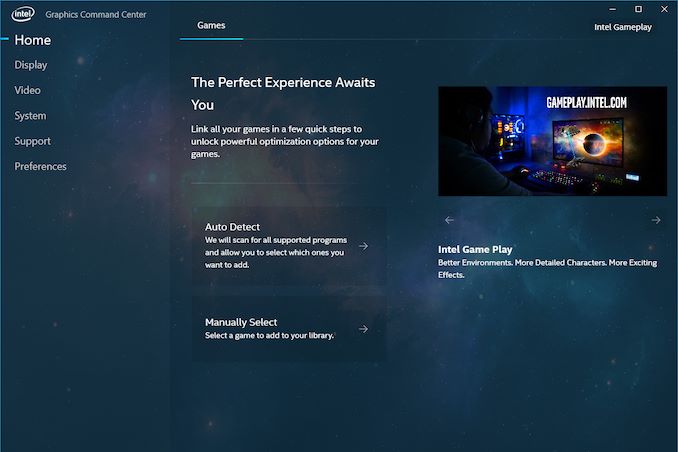
Making their own contribution to this busy week of GPU and gaming news, this evening Intel took the wraps off of their previously teased new graphics control panel. Dubbed the Intel Graphics Command Center, the new control panel – or to be more technically accurate, the new app – is an effort from Intel to modernize a part of their overall graphics infrastructure, replacing the serviceable (but not necessarily loved) current iteration of the company’s control panel. At the same time however, it’s also the first step in part of a larger process to prepare Intel’s software stack and overall software ecosystem ahead of the company’s ambitious plans to enter the discrete GPU market in 2020.
Starting from the top, Intel’s Graphics Command Center is largely cut from the same cloth as other modern graphics control panels, such as NVIDIA’s GeForce Experience and AMD’s Radeon Settings application. Which is to say, it’s designed to offer a highly visible and streamlined approach to a GPU control panel, making various features easy to find, and overall offering a more user-friendly experience than the company’s current control panel. And while Intel doesn’t go so far as to name names, from their presentation it’s clear that they consider this kind of user-friendly functionality to now be a required, baseline feature for any GPU ecosystem; in which case Intel is (or rather now, was) the only PC GPU vendor lacking an equivalent application.
To that end, the company is launching the new Graphics Command Center as part of their efforts to better support their current users, as well as new users going forward. The Intel Graphics Command Center works with 6th Gen Core processors (Skylake) and later, which at this point is most Intel-powered systems sold in the last few years. The company calls it an “early access” release, and this is a fairly apt description for the utility as while it shows a level of polish and stability that comes with over a year’s work, Intel clearly isn’t done adding features to it yet.
But perhaps the most interesting tidbit about the Graphics Command Center is how it’s being distributed: rather than being bundled with Intel’s drivers, it’s being delivered through the Microsoft Store on Windows 10. Yes, it’s a full-on UWP application with all of the “modern” flourishes that come with it, and this is actually an important part of Intel’s strategy. Because Microsoft’s new DCH driver model requires drivers to be stripped down to the bare essentials and delivered in pieces – graphics control panels can’t be bundled – these sorts of applications instead need to be delivered separately. In which case, using the Microsoft Store lets Intel tap into the OS’s built-in software update functionality. It also means that the control panel isn’t contingent on the checkered driver update schedules of PC OEMs; users can always download the Graphics Command Center out of band.
Overall, the Graphics Command Center borrows a lot from other GPU control applications. Front and center is a games-centric approach to settings, with the application preferring to offer game-specific settings when possible (scanning to discover what games are installed). For one of the 100 or so games on Intel’s list of supported games, this is relatively straightforward, and each game gets its own page with familiar driver-enforced settings such as anti-aliasing, v-sync, and anisotropic filtering.
Meanwhile, Intel has also thrown in some functionality to better explain what these graphics settings do, as well as their performance impacts. A small question mark next to each setting describes what the setting does, and includes photo demonstrating the concept as well. Meanwhile, towards the right of the control for that setting is an indicator to signal the performance impact of that setting, to offer a basic level of guidance about what the current setting will likely do to game performance. This is actually dynamic with the setting itself, so higher levels of MSAA are flagged as causing a greater performance hit, etc.
Going one step further, however, for 30 of those games, Intel also includes support for one-click graphics optimizations, which is indicated by the lightning bolt logo. Similar to how this works with other control panels, this function will actually go into a game and alter its settings to Intel’s suggested settings for the host computer. This allows Intel to adjust game settings on a fine-grained level, adjusting texture and shadow quality, rendering distance, internal AA settings, etc.
I’m told that right now most of the work to determine these settings is being done by hand by Intel engineers – and of that, I assume a lot of it is being taken from Intel’s existing gameplay settings service. However with 3 generations of iGPUs supported and more coming, the use of automation is increasing as well. As to the quality of Intel’s suggestions, I haven’t had nearly enough time with the Graphics Command Center to get a feel for them, though Intel makes it pretty easy to undo it as necessary.
Beyond game settings, the Graphics Command Center also supports all of the other common features you’d expect to find in a graphics control panel. There’s monitor display settings such as resolution and refresh rate, as well as arranging monitors. There are also a series of video quality settings for adjusting color correction, deinterlacing, film detection, etc. Not unlike the graphics settings, there are demo/explanation features here as well, in order to demonstrate in real-time what the various settings do. And of course, there are info panels on the current software and hardware, supported features, etc. This latter part is admittedly nowhere near groundbreaking, but if this is a baseline feature, then it needs to be present regardless.
Past the current functionality, it’s clear that Intel doesn’t consider themselves to be done with the development of their new graphics control panel. Besides adding support for more games – both for detection and one-click optimizations – there are several other features the other GPU vendors regularly support such as game recording. Performance monitoring, and game streaming. So I would be surprised if Intel didn’t eventually move towards parity here as well.
But ultimately the launch of their Graphics Command Center is about more than just improving the present; it’s about laying the groundwork for the future. The company is gearing up to launch it’s Gen11 iGPU architecture this year, and all signs point to the most common GPU configurations being a good deal more powerful than the Skylake-era GT2 configurations. And next year, of course, is slated to be the launch of Intel’s first Xe discrete GPUs. Intel has grand ambitions here, and to compete with NVIDIA and AMD, they need to match their software ecosystems as well, not just match them on the hardware front. So their latest control panel is an important step forward in establishing that ecosystem.
For the time being, however, Intel is just looking to polish their new control panel. As part of their Odyssey community feedback/evangelism program, Intel is very much embracing the “early access” aspect of this release, and is courting user feedback on the application. And while I admittedly suspect that Intel already knows exactly what they want to do and work on, it certainly doesn’t hurt to solicit feedback on this long road to Xe.
Source: Intel


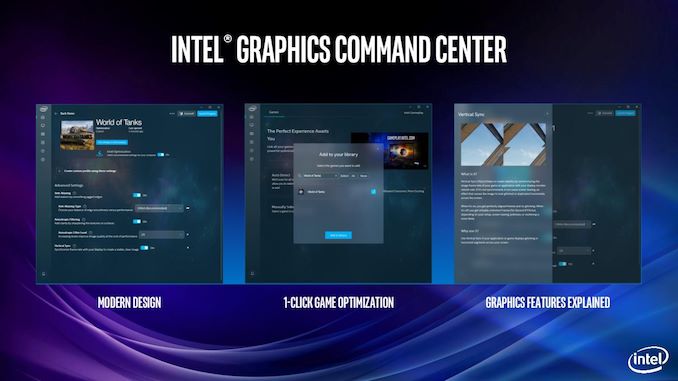
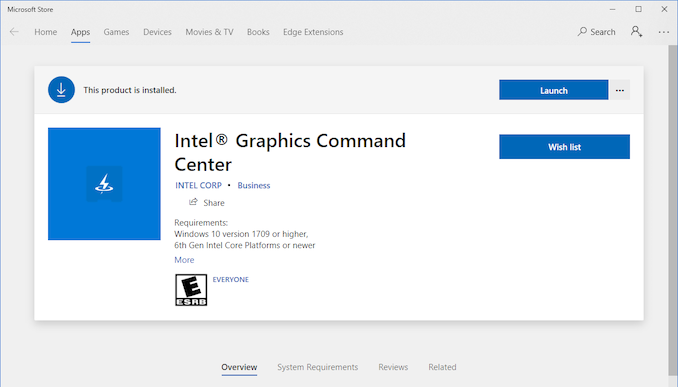







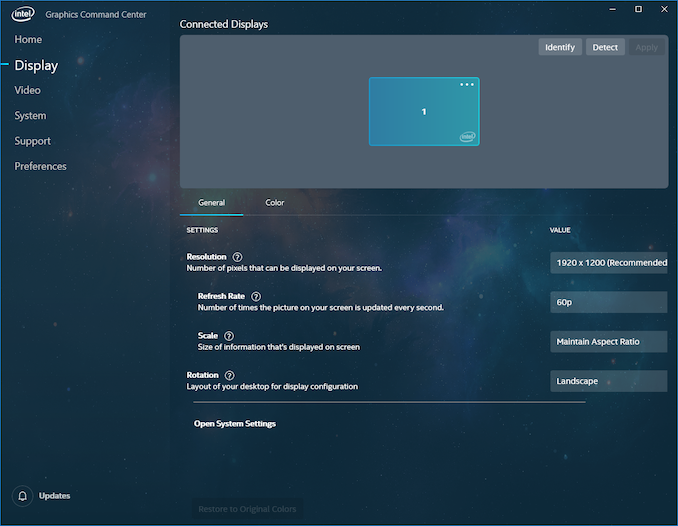
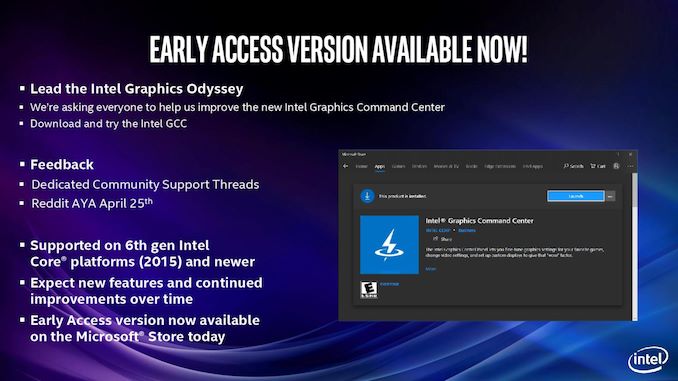














50 Comments
View All Comments
eddman - Friday, March 22, 2019 - link
"You can currently, however, install an UWP app, which you have obtained somehow on a server. It typically requires you to download on a consumer Windows and snatch the package during the install and before the auto-delete (...hacking, which is only fun the first time around)."So you didn't even open that link and you expect me to take your post seriously? Hacking? How about you read something that is provided to you before acting on your emotions.
Again, no one if forced to publish a store app. It is quite irrational to hold a personal grudge against something that hasn't even happened yet and shows no sign of happening for the foreseeable future. Dabbling in FUD is unhealthy for IT people.
abufrejoval - Friday, March 22, 2019 - link
Microsoft Shop links use a URL which starts with scheme name "ms-windows-store://".That scheme is not registered in Windows without the shop application, such as Windows Server 2019, which I run on some of my machines, because they run VMs, RDP sessions, file services etc.: They will *all* fail to open, no matter which application.
Intel's GCC isn't the only shop application I've tried to run on these machiens, Cinebench 20 was a recent other which isn't available outside the M$ store. In fact Maxxon issued take-down notices to sites, which were offering downloads of the app to those without a store: It seems there is quite a crowd out there who refuse to go near the store, knowing full well what game M$ is playing.
I did, however, manage to obtain a copy of Cinebench 20 from my Windows 10 system and install it on the server variant, so I know they can be installed. Most likely because Windows build farms may well run the Server edition for automated testing of the installer, before it's released to the store.
So no, since I was out of the country when I did my first post on the topic I did in fact not try to open the link. But I did try just now, first thing out of the airplane (to make sure you'd take me seriously) and it did behave exactly the way I predicted (404). And no, I didn't try to hack the "GCC" (GCC should really be reserved for the GNU compiler), because the Intel iGPU on these machines is actually disabled because they run RTX 2080ti and GTX 1080ti dGPUs.
Microsoft's agenda is no secret: They have a long tradition of copying what others have done successfully, usually late and usually with a vengance. They lost that game on Windows Phone, and more recently on the browser, they still play along with Bing search, but they seem to do alright on Azure.
I don't mind them starting independent new things, competing fairly and losing every now and then.
But when they force the worlds desktop population which has grown over three decades with indepdendent software distribution channels into a single absolutist shop, there are well documented precedents on how that should be dealt with. And we all know that they have Steam, Epic, Ubisoft and now Stadia on their target list.
Microsoft remembers those EU fines and proceeds with caution, but the lure of absolute power is as big as the potential rewards. Yet even the software and web giants sometimes react also to users, if the demonstrate their interest in sufficient numbers and conviction.
A recent example of that is the API that Chrome extensions for ad-filtering require, where Google was trying to create a privilaged position for themselves, strongly motivated by the fact that ad-filtering cuts their revenues.
After more than 35 years in the industry I know that everything that can go wrong, also will, unless you take care of it. I'd like you all to be careful, watch M$ and react with force to protect your interests as end-users.
eddman - Saturday, March 23, 2019 - link
404? That link works. I just clicked on it. Instead of copy-pasting it in the address bar, click on it. It opens up.Here's another: https://www.scconfigmgr.com/2016/04/05/deploy-offl...
In case this link magically doesn't work, have you ever tried searching for "how to install store apps on windows server 2016"?
The rest is FUD, again. There is no sign of side-loading and non-store applications going away any time soon. If you have a link where MS have started they are going in that direction please share, otherwise you are merely speculating.
eddman - Saturday, March 23, 2019 - link
Here is a microsoft Docs link with all the information on managing store apps for business: https://docs.microsoft.com/en-us/microsoft-store/eddman - Saturday, March 23, 2019 - link
The intel Graphics Command Center is bundled with the driver itself:https://downloadcenter.intel.com/download/28646/In...
abufrejoval - Saturday, March 23, 2019 - link
While I appreciate your willingness to help, you may want to re-read the original post and my responses.It's about Microsoft trying to establish a software distribution monopoly for the Windows platform with a combination of carrot and stick, in this case a certification requirement for drivers. I want to draw attention to that trend, because it signals major trouble going forward, not because I have difficulties installing Intel GPU Control Center on Windows Server 2019.
That their drive towards the monopoly fails to work seamlessly across Microsoft's platforms just highlights that they are doing bad things also badly.
IMHO the Intel “GCC” has zero end-user value today, because Intel does not yet produce GPUs sufficiently complex and powerful enough to benefit from such in-depth configuration. They are heavily invested into changing that but Microsoft’s Windows monopolist software strategy and certification requirements affects all hardware vendors today and increases the pressure on software vendors in general.
eddman - Saturday, March 23, 2019 - link
Microsoft have been distributing drivers since, IINM, windows vista. This is not much different.Their latest driver certification requirement says that drivers for windows 10 and server going forward must be in the Universal Windows format but there is no clause that says they should only be distributed through windows update/store.
Do you have anything that indicates MS is planning to prevent non-store software installations, besides your personal thoughts?
Actually, everything is pointing out to them becoming more open, even open-sourcing some of their software.
abufrejoval - Monday, March 25, 2019 - link
The univerwal windows format is the new name for Metro apps and this is what Wikipedia has to say about them:"Distribution and licensing
For most users, the only point of entry of Metro-style apps is Windows Store. Enterprises operating a Windows domain infrastructure may enter into a contract with Microsoft that allows them to sideload their line-of-business Metro-style apps, circumventing Windows Store. Also, major web browser vendors such as Google and Mozilla Foundation are selectively exempted from this rule; they are allowed to circumvent Microsoft guidelines and Windows Store and run a Metro-style version of themselves if the user chooses to make their product the default web browser."
Of course, the Wikipedia occasionally contains errors, but it represents a little more than my personal opinion.
Do you contest that Microsoft is trying to strong-arm the Windows platform into a Microsoft Store platform and make the store the exclusive distribution channel will all the benefits of control such a monopoly privides?
Do you contest that they are slowly and continously raising the bar and will only stop short of a practical monopoly if they face resistence and penalties?
If that's the case, arguments won't help you change your mind.
Open source these days has little to do with what Richard Stallman has in mind. Instead it has become a weapon in coporate's arsenal for market domination. Components these days are open sourced to starve the competition of market share and revenue. Just look at what Google has done with Kubernetes or many of the other examples over the last decades.
Microsoft is in open source mostly because they painfully learned that they cannot survive the competition with a free and open source OS software ecosystem, not because they agree with Richard Stallman's philosophy.
Perhaps I am too paranoid and Microsoft is as benevolent and open minded as you seem to believe. I'd love to be wrong, but in the mean-time I'd rather cry 'Wolf!', too.
eddman - Monday, March 25, 2019 - link
"Microsoft is as benevolent and open minded as you seem to believe."I never wrote they are benevolent. No company in the business of making money is, but you come to an unrelated article and post a rant about some uncertain future that might or might not become reality.
So far, there has been no indication that MS is planning to disallow non-store software distribution. Even these universal drivers are downloadable from their developers. I even posted the link. Windows server 2016 and 19 do not even have the store, so there must be an option for standalone driver installations.
Besides drivers, no developer is forced to make universal software. I haven't seen any news or even rumors that standalone exe installable programs are going to be prohibited.
This is not the place or the time for crying wolf. You do know what happened in the story, right? How about waiting for the signs of the actual "wolf" (when we get news of a possible store-only apps plan).
eddman - Monday, March 25, 2019 - link
Also, have you heard of MSIX? If they are planning to force everyone onto store, then why create a new packaging format since ten years ago that can easily be distributed independently?https://www.howtogeek.com/402021/the-future-of-sof...
https://insights.adaptiva.com/2019/msix-and-config...
https://www.advancedinstaller.com/msix-introductio...